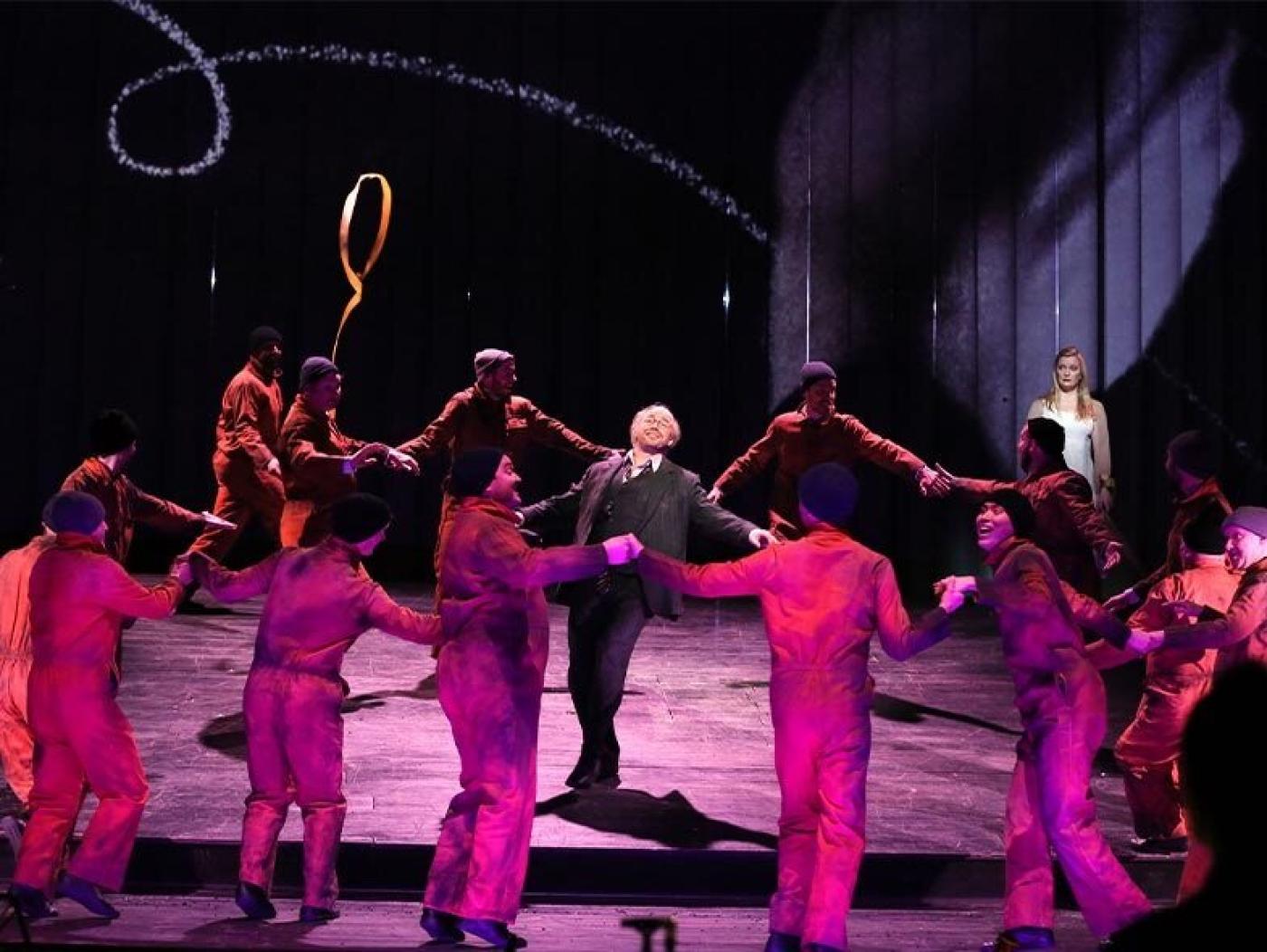In another opportunity to experience fine opera from the comfort of your personal screen, PBS presents “Great Performances at the Met: Die Zauberflöte” (The Magic Flute), a repeat of the Metropolitan Opera’s production from last season*. This final opera of Wolfgang Amadeus Mozart is one of the cornerstones of the opera repertoire, a fairy tale on its surface with an underlying morality play of human integrity and triumph of benevolence over evil. The Met calls Die Zauberflöte “a sublime fairy tale that moves freely between earthy comedy and noble mysticism.” PBS affiliate WETA Metro is pleased to broadcast this presentation on Sunday, January 7, 2024 at 9:00 a.m. (ET). A synopsis of each Act is provided below.
This Met production includes an all-star cast: Tenor Lawrence Brownlee as the hero prince, Tamino; soprano Erin Morley as Pamina, the young woman caught between her parents and their forces of good and evil; baritone Thomas Oliemans in his Met debut as the lovable birdcatcher and comic foil, Papageno; soprano Kathryn Lewek as the wicked Queen of the Night (a role with one of the most difficult and chilling coloratura arias in all of opera!) and bass Stephen Milling as the benevolent priest, Sarastro. Director Simon McBurney, in his Met debut, creates a new, innovative staging of acrobatics combined with sound and visual effects, a production that The Wall Street Journal called “the best production I’ve ever witnessed of Mozart’s opera.” Conductor Nathalie Stutzmann leads the orchestra from a raised pit, allowing us to see orchestra musicians interact with the cast. The opera is sung in German, supplemented by English subtitles.
Mozart composed the work for Emmanuel Schikaneder’s popular theater troupe in Vienna, and Schikaneder wrote the libretto based on fairy tales and medieval romances. It was designed for audiences of all ages, levels and interests, and is told in a Singspiel (“song play“) format that combines singing with spoken dialogue. Die Zauberflöte premiered to great success in Vienna in 1791, just two months prior to Mozart’s untimely death.
There are multiple layers and an allegorical plot at work here. Good triumphs over evil; knowledge defeats superstiton; light wins over darkness. Serious matters, but they are interspersed with many moments of levity, comedy and enchantment. Of course, Mozart’s glorious music weaves them all together with gentle arias, vibrant ensembles and a bit of fright.
Die Zauberflöte is thought to include elements of Freemasonary, a fraternal order of men who shared certain ideals and who bonded through the use of secret rites and rituals. Mozart and Schikaneder were Masons. Virtues of knowledge, truth, justice, silence, patience and reason are doctrines of Freemasonary. A similar set of ideals were tenets of the Age of Enlightenment, the era in which Mozart lived. We see these themes integrated into the plot. The character of Tamino, for example, endures a series of trials to determine his integrity and initiate him into the temple brotherhood, an allegory of the progress of humanity toward enlightenment. The high priest Sarastro guides his brotherhood by reason and understanding. The malevolent Queen of the Night – who some believe was intended to represent the Austrian empress Maria Theresa, an opponent of Freemasonary – is regarded as a symbol of superstition and therefore counter to the enlightened ideas of the brotherhood. And the number three, which is used in Freemasonry to represent the levels of masons, as well as the mind-body-soul connection in humans, is presented in various forms throughout the work. Even musically, we hear references to Masonic symbols, especially by the three prominent notes that open the Overture that represent three knocks on a door, a ritual to gain entry to a Masonic temple.
But we can enjoy this charming and heartwarming opera simply on the virtue of its music and story. At its heart, beneath the layers of allegory and symbols, is a love story and a young man’s journey – through trials and courage -- toward wisdom and benevolence by conquering villainous opposition with the help of a magic flute.
This presentation is a wonderful way to introduce young people to opera – but adults will enjoy it just as much. We hope you and your family will enjoy this Metropolitan Opera presentation of Mozart’s eternal classic.
Synopsis of Die Zauberflöte
Act I. The young Prince, Tamino, is chased by a serpent in the desert. He asks the gods to help him, then faints. Three attendants of the wicked Queen of the Night appear and kill the serpent. When Tamino awakes, he meets the birdcatcher (who dresses as a bird), Papageno, who takes credit for killing the serpent. Papageno sings of his longing for a wife, but the attendants put a lock on Papageno’s mouth for lying about killing the serpent. They give Tamino a picture of the lovely princess, Pamina, and Tamino instantly falls in love with her. They tell Tamino that Pamina has been kidnapped by her father, an evil demon named Sarastro, and being held in his temple. Tamino vows to rescue Pamina. The Queen of the Night appears and promises that if Tamino rescues her daughter, Pamina, he and Pamina may marry (“Oh, tremble not, my dear son. You will go to free her”.) The attendants remove Papageno’s padlock, warning him not to lie anymore. They give Tamino a magic flute that can turn sorrow to joy and give Papageno a set of magic bells for protection, as both set off to Sarastro’s temple to rescue Pamina.
At Sarastro’s temple, the sinister Monastatos tries to seduce Pamina, but she turns him away. Papageno arrives and tells Pamina that Tamino is on route to rescue her. Pamina is overjoyed. Three boys lead Tamino into the temple, assuring him that he will successfully rescue Pamina if he remains patient, steadfast and wise. Tamino tries to open three separate entrances to the temple, but only the Temple of Wisdom will open. A priest tells Tamino that Sarastro is benevolent and kind, and to enter the temple in a spirit of friendship. Tamino plays his magic flute, which causes animals to dance. Monastatos tries to capture Papageno and Pamina, but Papageno’s magic bells ward him off. Sarastro greets his daughter warmly and promises her protection from her mother, the Queen of the Night. He tells her that she must remain at the temple, and that both she and Tamino must undergo trials to be purified to achieve virtue and righteousness.
Act II. Sarastro and the brotherhood priests determine that Tamino may marry Pamina if he successfully passes trials through the Temple of the Ordeal. Sarastro hopes to keep Pamina away from the Queen of the Night, so prays to the gods to protect Pamina and Tamino and permit them entry into the gods’ heavenly home if they die during these trials. Before the trials begin, Tamino and Papageno are given the chance to turn back, but Tamino steadfastly wants to proceed. Papageno, on the other hand, is not interested in gaining wisdom, but when told he will be rewarded with a woman if he proceeds, he agrees to join Tamino in the trials.
In the first trial, Tamino and Papageno are ordered to remain silent, despite the appearance of three women who tempt the men to speak. Tamino holds steady, but Papageno breaks his silence. Meanwhile, in the temple garden, Pamina tells the Queen of the Night that she and Tamino are considering joining Sarastro’s brotherhood. The Queen, in a chilling aria of vengeance, orders Pamina to murder Sarastro or else the Queen will disown her ("Der Hölle Rache kocht in meinem Herzen" / Hell's vengeance boils in my heart). The evil Monastatos also threatens Pamina unless she gives in to his advances, but Sarastro appears and turns Monastatos away. Pamina asks Sarastro to forgive her mother, and he assures her that revenge is never welcome in this sacred temple ("In diesen heil'gen Hallen" / Within these sacred halls).
Tamino is praised for steadfastly remaining silent during the trial, but Sarastro instructs Tamino and Pamina to say their final farewells to each other before greater trials ahead. Pamina interprets Tamino’s silence as his rejection of her. Heartbroken, she attempts to kill herself, but three boys reassure her of Tamino’s love. Papageno speaks and uses his magic bells to summon the beautiful Papagena, but she is banished until Papageno has proven himself worthy.
Men announce that enlightenment is given to those who conquer a fear of death, and Tamino agrees to face this next and final trial. He is first granted permission to speak, so he reassures Pamina that he still loves her. Together, Tamino and Pamina face the trial of death by enduring fire and water, and emerge victorious with the help of Tamino’s magic flute. Papageno, meanwhile, uses his magic bells to reunite with Papagena. The villainous duo – the Queen of the Night and Monastatos -- reappear and attempt to destroy the temple, but are magically vanquished into the eternal night. Sarastro proclaims the victory of sun over darkness, and welcomes Tamino and Pamina into the temple as the brotherhood praises the pair for enduring the trials and offers thanks to the gods.
*This production is the standard full-length German language version, rather than the abbreviated, English-language version that the Met typically presents during holiday seasons.
Learn more about opera here!
PBS PASSPORT
Stream tens of thousands of hours of your PBS and local favorites with WETA+ and PBS Passport whenever and wherever you want. Catch up on a single episode or binge-watch full seasons before they air on TV.

